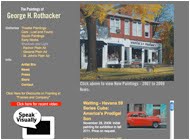 24" x 36" Acrylic on Canvas
24" x 36" Acrylic on CanvasGeorge H. Rothacker, 2009©
Collection of Leslie Wheeler
Soon after the stroke of midnight on January 1, 1959, an armed revolt led by Fidel Castro, overthrew the U.S.-backed dictator Fulgencio Batista of Cuba.
The movement that began in 1953, led to a commercial, economic and financial embargo that began in October 1960 and exists to this day, and which limits U.S. travel to the island nation.
In November 2009, Radnor, PA artist George H. Rothacker, traveled to Havana with his wife Barbara and two friends with the purpose of painting the city as it looks 50 years after the revolution.
“It is a beautiful city stuck in time,” commented George. “The people are friendly and the environment safe. But many of the great buildings continue to decay, and much of the city is impoverished.”
Through fall, 2011, George intends to paint the people, buildings and cars of Havana. “After the embargo, no new American cars were imported into the country, and today, cars from the late ‘40s through the 1950s serve as taxis and for personal transportation for many in Cuba. We were told by a guide that the Cubans are good mechanics, and manufacture many of their own parts for their vehicles, so the cars are a testimony to the emotional connection the Cuban people retain with the U.S., their hope that the embargo will soon end, and that relations with our country are restored.”
In April, 2009, despite overwhelming disfavor opinions of Fidel Castro, a CNN Opinion Research corporation poll showed that 64% of Americans surveyed believe that the U.S. should lift its travel ban on Cuba, while 71% think the U.S. should reestablish diplomatic relations with Cuba.
The movement that began in 1953, led to a commercial, economic and financial embargo that began in October 1960 and exists to this day, and which limits U.S. travel to the island nation.
In November 2009, Radnor, PA artist George H. Rothacker, traveled to Havana with his wife Barbara and two friends with the purpose of painting the city as it looks 50 years after the revolution.
“It is a beautiful city stuck in time,” commented George. “The people are friendly and the environment safe. But many of the great buildings continue to decay, and much of the city is impoverished.”
Through fall, 2011, George intends to paint the people, buildings and cars of Havana. “After the embargo, no new American cars were imported into the country, and today, cars from the late ‘40s through the 1950s serve as taxis and for personal transportation for many in Cuba. We were told by a guide that the Cubans are good mechanics, and manufacture many of their own parts for their vehicles, so the cars are a testimony to the emotional connection the Cuban people retain with the U.S., their hope that the embargo will soon end, and that relations with our country are restored.”
In April, 2009, despite overwhelming disfavor opinions of Fidel Castro, a CNN Opinion Research corporation poll showed that 64% of Americans surveyed believe that the U.S. should lift its travel ban on Cuba, while 71% think the U.S. should reestablish diplomatic relations with Cuba.




